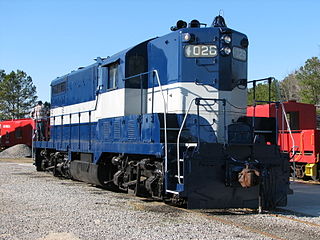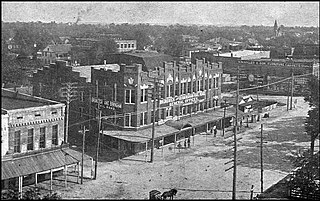Related Research Articles

Tift County is a county located in the south central portion of the U.S. state of Georgia. As of the 2020 census, the population was 41,344. The county seat is Tifton.

Tifton is a city in and the county seat of Tift County, Georgia, United States. The population was 17,045 at the 2020 census.

U.S. Route 319 is a spur of US 19. It runs for 303 miles (488 km) from US 98 at the foot of the John Gorrie Memorial Bridge across from downtown Apalachicola, Florida to US 1/SR 4 in Wadley, Georgia, through the Panhandle of Florida and the southern portion of Georgia.

The Atlantic Coast Line Railroad was a United States Class I railroad formed in 1900, though predecessor railroads had used the ACL brand since 1871. In 1967, it merged with long-time rival Seaboard Air Line Railroad to form the Seaboard Coast Line Railroad. Much of the original ACL network has been part of CSX Transportation since 1986.

The Louisville and Nashville Railroad, commonly called the L&N, was a Class I railroad that operated freight and passenger services in the southeast United States.

The Georgia Railroad and Banking Company also seen as "GARR", was a historic railroad and banking company that operated in the U.S. state of Georgia. In 1967 it reported 833 million revenue-ton-miles of freight and 3 million passenger-miles; at the end of the year it operated 331 miles (533 km) of road and 510 miles (820 km) of track.

The Atlanta, Birmingham and Atlantic Railway was formed in 1914 as a reorganization of the Atlanta, Birmingham and Atlantic Railroad, which had been created in 1905 to purchase the Atlantic and Birmingham Railway and extend its track into Birmingham, Alabama, from an end point at Montezuma, Georgia. The railroad's chief engineer and general manager at the time was Alexander Bonnyman.

The Atlanta, Birmingham and Coast Railroad was organized in 1926 to replace the bankrupt Atlanta, Birmingham and Atlantic Railway. The AB&C was controlled by the Atlantic Coast Line Railroad, which owned a majority of the stock. In 1944 it reported 763 million net ton-miles of revenue freight and 33 million passenger-miles; at the end of that year it operated 639 miles of road and 836 miles of track.

The Waycross Air Line Railroad, chartered in 1887, was an air-line railroad in Georgia. It began operations between Waycross and Sessoms in 1890. In 1901, the railroad had extended as far as Fitzgerald, Georgia, at which time its charter was amended for an extension to Birmingham, Alabama, and it was renamed the Atlantic and Birmingham Railroad. That company purchased the Tifton and Northeastern Railroad and Tifton, Thomasville and Gulf Railway on December 3, 1903, changing its name to the Atlantic and Birmingham Railway. In 1906, the Atlantic and Birmingham Railway was in turn purchased by the Atlanta, Birmingham and Atlantic Railway, which continued expansion towards Birmingham.
The Tifton, Thomasville and Gulf Railway (TT&G) was a railway that operated from Tifton, Georgia southwest to Thomasville, Georgia in the early 1900s. It later became part of the Atlanta, Birmingham and Atlantic Railway and Atlantic Coast Line Railroad networks.

The Brunswick and Birmingham Railroad (B&B) was a railroad in southeastern United States. Its main route ran from Brunswick, Georgia to Sessoms.
The Brunswick and Western Railroad is a historic railroad in southern Georgia that at its greatest extent ran from Brunswick near the coast to Albany. Segments of the line still exist today. The Brunswick and Florida Railroad ran from Brunswick west to Glenmore, where it would connect with the Atlantic and Gulf Railroad.

The Dixie Flyer was a premier named passenger train that operated from 1892 to 1965 via the "Dixie Route" from Chicago and St. Louis via Evansville, Nashville, and Atlanta to Florida. However, the train continued until 1969 as an Atlanta to Florida operation, run solely by the Atlantic Coast Line Railroad and its successor, the Seaboard Coast Line. The Flyer's route varied in early years, but by about 1920 was set as follows:
CSX Transportation's Atlanta Terminal Subdivision comprises the company's railroad lines and infrastructure operating in and around Atlanta, Georgia. The Atlanta Terminal Subdivision consists of five lines and a number of yards. Most of the lines in the Atlanta Terminal Subdivision date back to the 1800s.
The Lineville Subdivision is a railroad line currently operated by CSX Transportation in Georgia and Alabama. It runs from Parkwood southeast though Lineville, Alabama to Manchester, Georgia, a distance of 179.4 miles (288.7 km). It connects with CSX's Manchester Subdivision and Fitzgerald Subdivision in Manchester.
The Manchester Subdivision is a railroad line currently operated by CSX Transportation in Central Georgia. Its northern terminus is in Peachtree City, where it continues south from the Atlanta Terminal Subdivision. From Peachtree City, it runs for 38.8 miles (62.4 km) south to Manchester, Georgia, where it connects with CSX's Lineville Subdivision and Fitzgerald Subdivision. It is a major north-south route for CSX in Georgia.
The Southland was a night train between Chicago, Illinois and different points in western and eastern Florida from 1915 to 1957. In the early years it was called the New Southland. It was distinctive among Midwest to Florida trains as its western branch was the only all-season mid-20th-century long-distance train passing from Georgia to Florida bypassing the usual passenger train hub of Jacksonville Union Station. The main operator was the Louisville and Nashville Railroad, and pooling partners were the Pennsylvania Railroad, the Atlantic Coast Line Railroad and to lesser extent, the Wabash Railroad and the Florida East Coast Railway. For southeast bound -but not northwest bound- trips to Norfolk, Virginia, some coaches in 1946 diverged at Cincinnati along a Norfolk and Western Railway route. Northwest bound, travelers could switch trains at Cincinnati for heading towards Chicago.
The Atlantic Coast Line Railroad's Waycross—Montgomery Line was one of the company's secondary main lines running from Waycross, Georgia west to Montgomery, Alabama, a distance of over 300 miles. It was built in the late 1800s by the Atlantic Coast Line's predecessor companies. The line is still in service today and is now the Thomasville Subdivision and Dothan Subdivision of CSX Transportation, the Atlantic Coast Line's successor company through various mergers.
The Atlantic Coast Line Railroad's Albany—Thomasville Line was a historic railroad line in southern Georgia. Built in 1869 by the company's predecessors, it carried some of the Atlantic Coast Line's passenger trains on their routes from the Midwest to the Southeastern United States. The line is still in service today and is now operated by the Georgia and Florida Railway.
References
- 1 2 3 4 "Atlanta, Birmingham & Coast Railroad (GEORGIA'S RAILROADS, 1833-2015: Historic Context and Statewide Survey)" (PDF). Georgia Department of Transportation. Retrieved 8 August 2023.
- ↑ "Tifton History". Tifton, Georgia Official Site. Retrieved 9 August 2023.
- ↑ Moyer, Armond; Moyer, Winifred (1958). The origins of unusual place-names. Keystone Pub. Associates. p. 87.
- ↑ Storey, Steve (14 September 2018). "Railroads - Postwar Expansion and Consolidation". New Georgia Encyclopedia. Retrieved 8 August 2021.
- ↑ Tifton And Northeastern Railroad (in Italian). Log Press. ISBN 6200371601.
- ↑ "Wesley Thomas Hargrett collection". sclfind.libs.uga.edu. Hargrett Manuscripts and Russell Library Finding Aids. Retrieved 8 August 2021.
The collection consists of the papers of Wesley Thomas Hargrett from 1889-1919. The materials pertain to business operations of various Georgia railway companies
- ↑ "Georgia Railroads: Passenger Stations & Stops" (PDF). The Branch Line Society. Retrieved 1 August 2023.